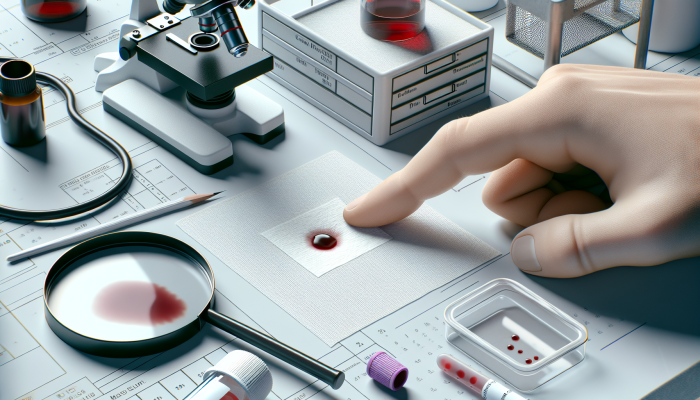Ultimate Guide to Understanding Dried Blood Spot Testing and Its Impact
Exploring the Importance of Dried Blood Spot Testing in Healthcare

Dried blood spot testing represents a revolutionary advancement in the methodology of blood sample collection and analysis, fundamentally transforming how healthcare providers diagnose and treat patients. In this innovative procedure, a minute drop of blood is strategically placed on specially designed filter paper, which subsequently dries before being dispatched to a laboratory for thorough evaluation. This method not only streamlines the sample collection process but also significantly diminishes the risks associated with more invasive techniques, such as traditional venous blood draws. The importance of this approach lies in its capability to facilitate precise and timely diagnoses, especially in regions where healthcare access is limited. By embracing this technique, healthcare practitioners can enhance patient outcomes and promote effective health management strategies.
The process of collecting samples via dried blood spot testing is particularly beneficial for patients, as it is notably less traumatic, making it a preferred option in pediatrics and among at-risk populations. These dried samples boast the advantage of being storable for extended periods without the need for refrigeration, rendering them an optimal choice for public health studies and diagnostics in remote locations. Additionally, this innovative technique permits the analysis of multiple biomarkers from a single collected sample, thereby conserving both time and resources as compared to conventional testing methods. Overall, the emergence of this testing methodology is significantly reshaping the landscape of medical diagnostics.
Tracing the Historical Development of Dried Blood Spot Testing
The evolution of dried blood spot testing can be traced back to the 1960s and 1970s when it was first introduced for the early detection of metabolic disorders in newborns. Since its initial application, substantial advancements have been made in the precision of both the technique and the analyses conducted. The rapid pace of technological progress has enhanced sample collection and analysis strategies, allowing this method to extend its reach into various applications within clinical medicine.
In recent years, there has been an accelerated push towards adopting dried blood spot testing across diverse fields, including monitoring infectious diseases, pharmacogenomics, and epidemiological studies. This evolution is largely attributed to significant improvements in the sensitivity and specificity of testing protocols, as well as the validation of analytical methodologies that guarantee result reliability. Today, this technique is acknowledged worldwide as a crucial tool for diagnosing and tracking a wide range of health conditions, underscoring its growing significance in modern medical practices.
Discovering the Key Benefits of Dried Blood Spot Testing
One of the most notable benefits of dried blood spot testing is its inherent user-friendly nature. The simplicity of the procedure makes it feasible to conduct in a variety of environments, from clinical settings to home-based applications, thereby significantly enhancing access to diagnostic testing. Furthermore, the sample collection process does not necessitate highly trained personnel, effectively reducing operational costs and allowing a broader spectrum of individuals to benefit from this innovative method.
An additional compelling feature is the portability of the dried samples. Once the blood spots have dried, they can be transported without the need for special storage conditions, which is particularly advantageous in public health contexts and remote areas. This capability supports the implementation of mass screening initiatives and the monitoring of disease outbreaks. Moreover, the ability to analyze multiple analytes from a single sample further optimizes resource utilization in medical diagnostics, making it a highly efficient option for healthcare providers.
Real-World Applications of Dried Blood Spot Testing in Medicine

Revolutionizing Newborn Disease Detection with Dried Blood Spot Testing
The application of dried blood spot testing in the detection of neonatal diseases has dramatically changed the landscape of diagnosing and managing potentially life-threatening conditions in infants. This method facilitates the early identification of various metabolic, endocrine, and genetic disorders, which is essential for initiating timely treatments that can save lives. For instance, serious conditions such as phenylketonuria and congenital hypothyroidism can be swiftly detected using this approach, enabling healthcare providers to implement prompt interventions that avert long-term complications and promote healthier outcomes for newborns.
The implementation of neonatal screening programs that incorporate dried blood spot testing has proven to effectively reduce morbidity and infant mortality. Typically, newborns are screened within the first 48 hours of their lives, ensuring that any identified conditions receive immediate attention and treatment. Furthermore, the capacity to perform tests in home settings or community environments has significantly enhanced coverage and accessibility, benefiting populations that previously lacked adequate access to quality healthcare resources.
Essential Contributions of Dried Blood Spot Testing in Medical Research
The versatility of dried blood spot testing extends well beyond clinical diagnosis, playing a crucial role in advancing medical research. Clinical studies frequently employ this technique to collect blood samples in a less invasive manner, which facilitates longitudinal data collection and ongoing health monitoring over time. Researchers can utilize dried blood samples to analyze biomarkers, conduct pharmacokinetic studies, and assess the efficacy of novel treatments.
Epidemiological research also greatly benefits from this innovative technique. For example, studies aimed at assessing the prevalence of infectious diseases such as HIV and hepatitis have effectively utilized dried blood spot testing to investigate affected populations in various contexts. The ability to store and analyze samples over prolonged periods enables the collection of valuable data that can influence public health strategies and inform health interventions.
Utilizing Dried Blood Spot Testing for Effective Therapy Monitoring

The role of dried blood spot testing in monitoring therapy is an expanding area of interest, particularly in the context of chronic treatments and complex diseases. Healthcare providers can leverage this technique to optimize medication dosages, ensuring that patients receive the precise amount needed to maximize treatment effectiveness while minimizing adverse effects. This precision is particularly crucial for medications that have a narrow therapeutic index, where accurate dosing is vital to patient safety and treatment success.
Furthermore, dried blood spot testing allows healthcare professionals to continuously monitor drug levels in patients' systems, facilitating timely treatment adjustments based on individual responses. This is especially critical in fields such as oncology and pain management, where tailored treatment approaches can significantly improve patient outcomes. The simplicity and efficacy of this method make it an invaluable asset in contemporary clinical practice.
Step-by-Step Procedures and Techniques for Dried Blood Spot Testing
Detailed Sample Collection Protocols for Dried Blood Spot Testing
Collecting samples for dried blood spot testing necessitates meticulous attention to detail to ensure the highest quality of samples. The process begins with the preparation of essential materials, including specific filter papers and devices for blood collection. Adhering strictly to standardized protocols is crucial to minimize contamination risks and guarantee reliable results.
Once all necessary equipment is prepared, the next step involves puncturing the patient’s finger or heel, depending on the age and context of the patient. The volume of blood required for this test is minimal; typically, only a few drops are necessary. These drops are carefully applied onto the filter paper, ensuring they are adequately absorbed and evenly distributed. After collection, it is vital that the samples are completely dried before being stored or sent to the laboratory, as insufficient drying can compromise the sample's integrity.
Advanced Techniques for Analyzing and Processing Dried Blood Samples
The analysis of samples collected through dried blood spot testing employs a variety of biochemical and molecular techniques. Upon arrival at the laboratory, the dried samples are rehydrated and prepared for comprehensive analysis. Depending on the specific condition or biomarker being evaluated, methodologies such as mass spectrometry, liquid chromatography, and various immunoassay techniques may be employed.
Each analytical method offers distinct advantages regarding sensitivity, specificity, and speed. For instance, mass spectrometry is renowned for its high accuracy and ability to simultaneously identify multiple analytes. The selection of the appropriate analytical technique will depend on the study's objectives and the resources available. Additionally, laboratories must adhere to stringent quality control measures to ensure the validity of results obtained from dried blood spot testing samples.
Decoding the Interpretation of Results from Dried Blood Spot Testing
Interpreting the results derived from dried blood spot testing is a critical aspect that necessitates specialized expertise. Healthcare professionals must consider numerous factors, including reference values, the patient’s clinical history, and specific conditions surrounding the sample collection. Accurate interpretation of test results is crucial in guiding essential treatment and management decisions for patients.
It is vital to acknowledge that while dried blood spot testing serves as a powerful diagnostic tool, it does not replace all conventional diagnostic tests. The results should be contextualized within a broader clinical framework, and in certain situations, additional testing may be required to confirm diagnoses or evaluate treatment efficacy. Clear communication of results between healthcare providers and patients is essential to facilitate informed health management decisions.
Understanding the Advantages and Challenges of Dried Blood Spot Testing
Distinctive Advantages of Dried Blood Spot Testing Over Traditional Methods
The benefits of dried blood spot testing in comparison to traditional diagnostic methods are numerous and substantial. Primarily, the simplicity of the collection process significantly reduces patient discomfort and minimizes the risks associated with invasive procedures. Additionally, the capability to store and transport samples without refrigeration is a decisive factor in its widespread adoption in both clinical and research settings.
Another significant advantage is the ability to analyze multiple biomarkers from a single sample, optimizing both resources and time when compared to the need for multiple samples for individual tests. This efficiency is especially vital in the realm of personalized medicine, where comprehensive health profiles can be derived from a single analysis. Furthermore, this technique has demonstrated effectiveness in mass screening efforts, enabling the early identification of diseases in populations that are often difficult to reach, thereby enhancing overall public health outcomes.
Identifying Challenges and Limitations of Dried Blood Spot Testing
Despite its many advantages, dried blood spot testing also faces several challenges and limitations that must be considered. One primary obstacle is the variability in the quality of the collected samples, which can directly impact the accuracy of results. Factors such as the technique used for puncturing, drying time, and the conditions during transportation can all affect sample integrity.
The interpretation of results can be complex, particularly for conditions that require detailed assessments. It is essential for healthcare professionals to be adequately trained to manage and analyze results accurately. Lastly, while the technique has advanced significantly, the validation of new methods and biomarkers is still necessary to ensure the reliability and widespread acceptance of dried blood spot testing in clinical practice.
Looking Ahead: Future Prospects of Dried Blood Spot Testing
The outlook for dried blood spot testing is highly promising, with ongoing advancements in technology and methodologies that continue to expand its applications. The integration of cutting-edge analytical technologies, such as genomic sequencing and metabolomics, facilitates a more comprehensive assessment of patient health and the early detection of emerging diseases.
Moreover, it is anticipated that the incorporation of this technique into public health initiatives will increase, thereby enhancing access to diagnostic testing in underserved communities. Collaboration among researchers, healthcare practitioners, and regulatory bodies will be essential for overcoming existing challenges and promoting the widespread implementation of dried blood spot testing. As new applications emerge and innovative methods gain validation, this approach has the potential to revolutionize the diagnosis and management of diseases, establishing itself as a foundational element in the future of healthcare.
Case Studies and Real-World Examples of Dried Blood Spot Testing
Highlighting Success Stories in Early Detection of Diseases
Numerous success stories illustrate the effectiveness of dried blood spot testing in early disease detection during critical situations. For example, several countries have adopted this methodology in neonatal screening programs to identify metabolic disorders. A notable study conducted in Sweden revealed that early detection of phenylketonuria through dried blood spot testing enabled specific dietary interventions that dramatically improved patient health outcomes.
Another significant example involves using dried blood spot testing to identify infectious diseases. In a public health initiative in Africa, dried blood samples were used to swiftly diagnose HIV in hard-to-reach communities. This approach not only facilitated timely diagnosis but also enabled immediate interventions to reduce virus transmission, highlighting the critical role of this testing method in enhancing public health.
The Role of Dried Blood Spot Testing in Public Health Programs
The integration of dried blood spot testing into public health initiatives has emerged as an invaluable resource in combating both infectious and chronic diseases. This technique has been employed across various regions worldwide for epidemiological studies and mass screening programs targeting diseases such as malaria and hepatitis. The ability to efficiently collect and analyze blood samples empowers health authorities to make informed decisions and allocate resources effectively to areas in dire need.
Additionally, dried blood spot testing has significantly enhanced the capacity to respond to epidemic outbreaks. During public health emergencies, such as the COVID-19 pandemic, this technique has provided a practical tool for surveillance and control of virus spread, enabling swift identification of cases and the execution of appropriate public health measures.
Innovative Advances in Dried Blood Spot Testing
Ongoing innovations in dried blood spot testing are propelling its evolution and expansion within clinical practice. One of the most significant advancements has been the improvement of analytical technologies, which now allow for the detection of biomarkers at lower concentrations and with greater accuracy. This progress has broadened potential applications in areas like pharmacogenomics, where patient responses to specific medications can be effectively assessed from a dried blood sample.
Furthermore, the development of portable devices for sample collection and analysis has facilitated the implementation of dried blood spot testing in community and rural settings. These devices empower healthcare professionals to conduct diagnostic testing on-site, enhancing access to medical care for underserved populations. The future of this technique is in continuous development, and its integration into medical practice holds the promise of transforming the diagnosis and management of diseases.
Frequently Asked Questions about Dried Blood Spot Testing
Does Dried Blood Spot Testing Cause Pain?
The procedure associated with dried blood spot testing involves a minor puncture in the skin, akin to a needle prick. Most patients report experiencing minimal discomfort, as modern techniques are designed to minimize any potential pain.
Where Can I Obtain a Dried Blood Spot Test?
Dried blood spot testing can be performed in hospitals, clinics, and specialized laboratories. Additionally, several public health programs offer options for home collection.
Which Diseases Can Be Detected Using Dried Blood Spot Testing?
This testing method is effective in identifying a variety of diseases, including metabolic disorders, infections like HIV and hepatitis, as well as genetic conditions. Its versatility enables a wide range of diagnostic applications.
What Is the Expected Turnaround Time for Results?
The turnaround time for results from dried blood spot testing can vary between laboratories but generally falls within a range of 3 to 10 days, depending on the analysis being performed.
Is Fasting Necessary Prior to the Test?
Fasting is typically not required for dried blood spot testing. However, it is recommended to follow any specific instructions provided by the healthcare professional conducting the test.
What Precautions Should Be Taken When Storing Samples?
Samples from dried blood spot testing should be stored in a cool, dry environment, away from direct light and humidity. This storage practice is essential to maintain the integrity of the sample until analysis.
Can Dried Blood Spot Testing Replace Other Diagnostic Methods?
While dried blood spot testing is highly effective, it is not intended to replace all conventional diagnostic methods. Its use should complement existing procedures based on comprehensive clinical evaluations.
What Are the Typical Costs Associated with the Test?
The costs of dried blood spot testing may vary based on the laboratory and specific tests performed. It is advisable to consult with the healthcare institution for accurate pricing information.
Are There Any Risks Linked to This Test?
The risks associated with dried blood spot testing are minimal, as the collection involves a minor puncture compared to other techniques. Nonetheless, there is a slight risk of infection at the puncture site.
What Should I Do If My Results Are Abnormal?
If your dried blood spot testing results are abnormal, it is crucial to consult with a physician for appropriate follow-up and to determine the next steps, including any necessary additional testing.



This is a fascinating topic! I’ve always been intrigued by how technology can reshape healthcare, and dried blood spot testing really seems like a game changer. I remember reading about its use in newborn screening programs, which is a pretty vital area. It’s amazing how something as simple as a drop of blood can lead to early detection of serious conditions, especially in remote areas where traditional testing is hard to access.
I agree, it’s really intriguing how technology can bring about such significant changes in healthcare. Dried blood spot testing indeed has a lot of potential, especially in early detection. It’s fascinating to consider how something so small can have such a major impact on preventing serious health issues in newborns.
You’ve hit the nail on the head! It’s wild to think how something as tiny as a dried blood spot can be a superhero in the world of healthcare. Imagine a little drop of blood swinging into action like a pint-sized detective, sniffing out potential problems before they can even say “boo.”
Absolutely! If you’re interested in learning more about the advancements and benefits of dried blood spot testing in newborn health, check out this insightful resource [here].
https://ezbloodtest.com/KetoBreads
You touch on an exciting aspect of dried blood spot testing. It really is remarkable how such a small sample can unlock so many vital insights, especially when you consider its role in newborn screening. The potential of this technology to reach underserved communities is incredibly promising.
I’m glad you found the topic fascinating! If you’re interested in learning more about the potential of dried blood spot testing and its impact on healthcare, check out this insightful resource.
https://ezbloodtest.com/VideoLeap
This is such an interesting exploration of dried blood spot testing! I’ve definitely seen a surge in discussions around less invasive medical techniques lately. It’s impressive how this method can improve accessibility, especially in remote areas. I wonder how it impacts patients’ willingness to get tested for things like chronic diseases or screenings.